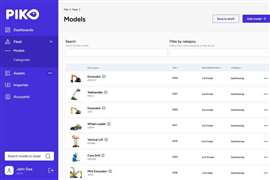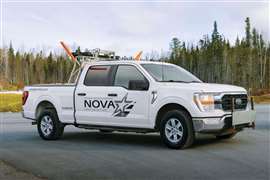Quantum leap in road building
14 June 2013
.gif)
This year’s Bauma exhibition in Munich, Germany was a huge event for the road building sector, in part because so much road building equipment is built in Germany. It is the home market of the likes of the Wirtgen Group and Bomag, part of France’s Fayat. And like Fayat, many other manufacturers in the sector produce machines in Germany.
And earlier in the year, exhibitions like World of Asphalt and World of Concrete in the US gave other opportunities for road building equipment makers to introduce new products and technologies to their customers. And there is a big emphasis on technology in the sector, be it in concrete or asphalt paving.
One aspect of this of course are the Stage IIIB/Tier 4 Interim engine laws in Europe and the US, and their Japanese equivalent, which are seeing manufacturers fit new low-emission engines to their road building machines. But in addition to this, new more sophisticated control systems are being added, along with options for telematics and machine control devices to further improve accuracy and efficiency.
Take GOMACO for example. It used Bauma to premier the latest version of its GHP-2800 concrete paver, which now features the company’s proprietary G+ Connect controller. This allows fast, two-way communication between all accessories, on-board hydraulics and electronics and the controller, loaded with GOMACO’s new paving software, via a Controller Area Network (CAN).
The system makes for faster, more precise setup and paving operations and is programmed to operate in numerous languages. A ‘run’ screen on the control panel illustrates the various aspects of the paver. It includes leg positioning, paving speed and percentage of drive, steering, travel information, grade information, deviation metres, and more. Colour graphics make it easy to understand and easy to identify functions and the system also carries a detailed fault history with date & time information.
In the asphalt paving segment, Dynapac has launched a new version of its SD2550CS paver, which comes with a new version – 2.0 – of its Pave Manager control system. The paver is suitable for highway paving up to 14 m wide, with a theoretical production capacity of 1,100 tonnes per hour. The 60 kW screed heating system helps ensure faster warming over the full working width, while the hopper has a 15 tonne capacity feeding the screed through a 1.3 m wide material tunnel.
Features include a new dashboard designed to be comfortable to use, and packed with features suggested by operators. An example is the large toggle switches for screed extension and levelling, which are easy to use even when wearing thick gloves.
The upgraded Pave Manager 2.0 operating system, with colour display, offers an improved operator interface and new features such as direct access buttons to key functions on the main dashboard, improved display of screed control as well as additional paving functions.
Caterpillar meanwhile has been updating control systems on its compactors. The Cat compaction control system on the CB44B and CB54B, and the CD44B and CD54B 7 to 11 tonne tandem rollers combines infrared temperature sensors with mapping to keep the operator informed of current mat temperatures, machine position, and coverage completion. This system also records information for future process analysis and quality control documentation.
Operators will also notice the new control system on the rollers, which replaces a traditional steering wheel with a joystick on the right and hand wheel on the left of the seat. Caterpillar says this is a more ergonomic system, which is more intuitive than traditional controls and which also offers improved visibility.
Ammann meanwhile is offering its ACE compaction measurement, control and documentation system on its new ARP 95 9 tonne class tandem roller and the smaller AR 85. The machines have been updated with Stage IIIB engines and Ammann has taken the opportunity to redesign the ARP 95’s frame to improve the layout and comfort for the operator.
The ACE system helps simplify the operator’s job by adjusting the frequency and amplitude of vibration depending on the measurements it takes of the asphalt’s temperature and bearing capacity. It also logs and documents the data.
Bomag meanwhile is now offering its Economizer compaction monitoring system on its range of light tandem rollers – a feature it says is a world first for machines in this size class.
The Economiser system is designed to take the guesswork out of compaction with small rollers, by providing a simple display to monitor compaction progress and identify any soft spots. This information is relayed to the operator via a simple LED indicator. Once the number of lights being illuminated stops increasing, the material is fully compacted, and so any soft spots will be indicated by a sudden drop-off in the ring of lights.
The Bomag Economizer is now available as an option for all of the company’s 5th generation small tandem rollers, from the 1.8 tonne BW80 to the 4.3 tonne BW 138.
Telematics is another area where technology is changing the way road building machines can not only be used, but monitored, managed and even repaired. Roadtec for example now provides its Guardian telematics system as standard on all of its Tier 4 interim milling machines (designated by an ‘e’ in the product number).
Company president Jeff Richmond said, “There are literally hundreds of machine factors that can be monitored in real time and a number of machine functions that we can fix over the Internet. When a customer calls in, we’re going to be able to fix him over the phone.”
The company’s latest addition to its range is the milling range is the RX-100e, a compact machine capable of a 203 mm cut depth over its 0.5 m drum width. “We’ve always been big in the big milling market, but not so much in the smaller stuff, so the RX-100e is important for us,” said Mr Richmond.
Features on the machine include the ability to reposition the right-rear leg to allow milling to be carried out flush to a curb or other obstruction. Power comes from a 103 kW Cummins engine and the drum drive is hydraulic. There is also a variable speed fan, which provides the correct amount of cooling at any one time, rather than running at a fixed speed, which may be wasteful.
Sister company Astec meanwhile has launched a new system called Data Acquisition System Hub (DASH), which provides a real-time snapshot of operations from multiple mixing plants, which is accessible over the web.
This allows managers to analyse trends and better understand their plant operations. The system is compatible with a range of Astec’s control systems and can be accessed by smart phones and tablet computers as well as traditional desktop machines.
Game changer?
The Wirtgen Group meanwhile has taken telematics one step further with its new Witos system, which was unveiled at Bauma. This combines the functions of a telematics fleet management system, along with software for process optimisation. The company says this makes it possible to optimise the entire road building chain, including milling, paving and compaction, as well as adopting a just-in-time approach to the process.
It is a modular system, with two main parts – Fleet Management and Process Optimisation. Within the fleet management section, sub-sections include Fleet View for an overview of all machines – this can be interrogated for detailed data on any one unit, Fleet Care for planning maintenance and Smart Services, which allows Wirtgen’s service technicians to monitor machines as part of a service agreement.
The Process Optimisation side meanwhile is divided into Paving, Milling and Compaction sections, and the company says that there is huge potential for improvement here. It says that anywhere from 60% to 85% of the time spent on an asphalt road building project is non-productive due to inefficient processes and faults. Adopting lean management systems, which can be facilitated through Witos could take a big chunk out of these losses.
The Paving module, for example, uses a telematics system to integrate the entire asphalt paving process, from planning to control, based on paving parameters, such paver operating speed or pave width, and checking them for consistency.
During construction, the loading of trucks is monitored at the asphalt mixing plant via the Internet. When it is unloaded on site, the paving crew records the precise unloading time using the terminal on the paver. Continuous documentation of this timestamp and real time data transmission ensure a high level of transparency in the supply chain for both the mixing supervisor and the paving crew. This function tells them when a specific truck is expected to arrive at the mixing plant or site.
This opens up a huge number of possibilities, from control of all construction workflows in real time, to ensuring continuous paving, increasing quality, increasing lay-down rates and minimising non-productive time.
Similar possibilities exist through the compaction and milling modules. The compaction module ties in with existing technology from Wirtgen’s specialist subsidiary Hamm, such as the HCQ Navigator system for tracking and documenting the process. What’s more, the various modules can be inter-linked, allowing for road building work to be optimised as a whole, not just in the separate functions of milling, paving and compaction.
Encouraging road contractors to adopt the kind of technology that Witos embodies could be a challenge for Wirtgen, but the potential prize in terms of cost and time savings could be enormous.







